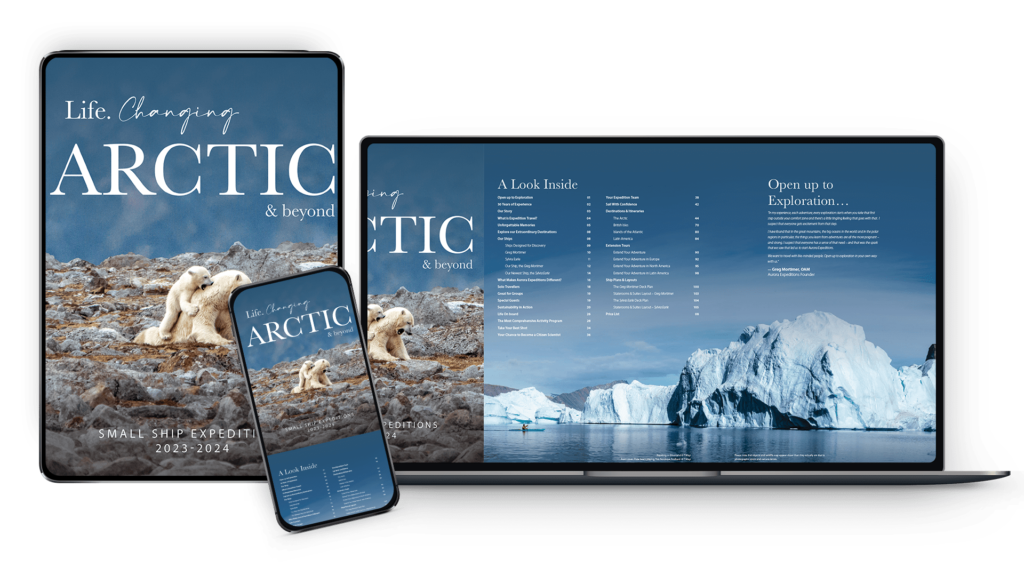One of the challenges of exploring the Norwegian archipelago of Svalbard is the prominence of pack ice. Throughout the winter months, pack ice covers much of the Arctic Ocean and surrounding vicinity, making it difficult to travel through.
However, during autumn, there is a much different picture in the northern isles of Svalbard. The pack ice opens up and we able to land on some of most isolated islands in the world. These islands are home to many unique Arctic wildlife and birdlife species – largely untouched by humans.
Keen to learn a little more about the various islands of Svalbard? Here’s what you need to know!
Spitsbergen
At 37,673 square kilometres, Spitsbergen is the largest and only permanently populated island in the archipelago – home to around 3,000 residents. Zodiac-cruise under towering cliffs noisy with bird-chatter from glaucous gulls, fulmars and Brünnich’s guillemots that nest on the island’s towering cliff faces. In some places on the island, it’s possible to see over 100 walruses hauled out at a time.
On the north-west corner of the island is Nordvest-Spitsbergen National Park, which seems to rise from the sea in high alpine peaks and deep glacial valleys. Keep your eyes peeled and camera ready for reindeer and Arctic foxes darting across the snow, and walrus lounging on the shoreline!
There are also two small islands off the coast of Spitsbergen – Amsterdam Island and Ytre Norskøya. The former is where you can explore the region’s calving glaciers, while the latter was the site of whaling stations during the 19th century. The remains of a whaling station still stand, exposed to the bracing conditions, providing insight into this now illegal industry.
Read more: What sorts of food do people eat in the European Arctic?
Nordaustlandet
To the north-east of Spitsbergen sits the second largest island in the archipelago, Nordaustlandet. On this island, you won’t find any settlements or signs of civilisation – just reindeer, walruses and a whole lot of ice!
Of course, this doesn’t mean that Nordaustlandet is any less interesting than Spitsbergen! In fact, if you’re interested in geological wonders, this is the place to be.
Across the island, there are countless geological sites dating back to different time periods. For example, distinctive red-coloured granite can be seen in the east and south, while old crystalline basement can be found in the north.
As the archipelago is so widespread, Sjuøyane (The Seven Isles) is the most northern point in Norway. If you’re lucky you might spot a roaming polar bear hunting for its next meal or a colony of walruses enjoying the late autumn sun on the beach.
There is also outstanding Arctic birdlife to be seen throughout northern Svalbard – with Glaucous Gulls, Brunnichs Guillemot and Little Auks nesting around the shoreline – have your camera locked and loaded to avoid missing a beat!
Read more: Top 10 things to see on a Spitsbergen cruise
Storøya, Kvitøya and Karl XII Island
Depending on weather conditions and pack ice, one may have a chance to land on land on Storøya, Kvitøya and Karl XII Island.
Storøya is the first landing point in this easternmost part of Norway and is a small island home to the Storøyjøkulen glacier. Reaching a height of around 250 metres above sea level, the glacier is a combination of thick ice and snow.
Kvitøya, further east of Storøya, is much larger at around 682 square kilometres and is covered entirely by a thick ice cap. It’s important to highlight that there are only a few square kilometres on Kvitøya that aren’t covered by ice, making the view worth a thousand photos.
On a historic note, Kvitøya is the site of the special monument which commemorates the 1897 Arctic balloon expedition. The plan was to fly a hydrogen balloon over the North Pole, but the three-man team were forced onto the pack ice around Kvitøya during bad weather. While the men managed to reach the island via the pack ice, the expedition party died within two weeks of landing.
In 1930, a ship found the remains of the men, balloon and expedition equipment which included photographs and scientific observations.
Read more: Spitsbergen birdlife to spot on your Arctic cruise
Murchisonfjorden
Completing the circumnavigation of Nordaustlandet, cruise up the Hinloppen Strait to Murchisonfjorden. This magnificent fjord features steep coasts and countless small islands where birdlife nest and walruses and polar bears can be seen roaming.
Named after famous British geologist Roderick Murchison, this area is perfect for exploration by Zodiac cruise, so you can access intimate bays bigger crafts can’t reach.
Experience natural beauty of Svalbard

Arctic & Beyond 2024 Season Brochure
Explore our Arctic & Global 2024 season, full of life changing adventures across the wildest and most remote destinations around the globe. Choose from 15 departures exploring the Arctic and 3 voyages to our hand-picked Global destinations.
Dive into our comprehensive 112-page brochure and find your next life-changing adventure.

